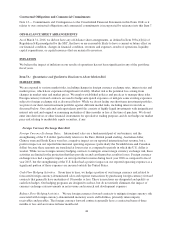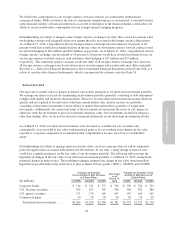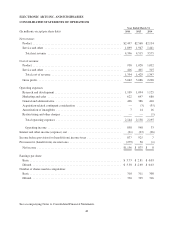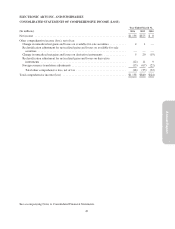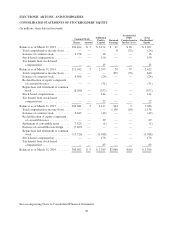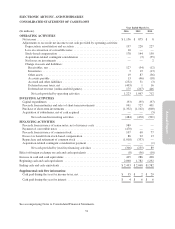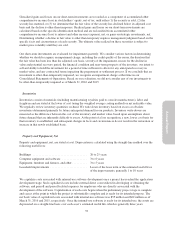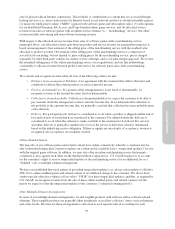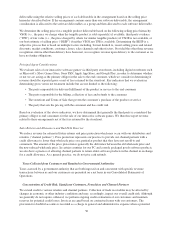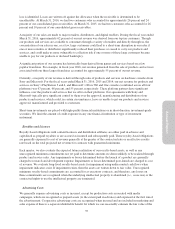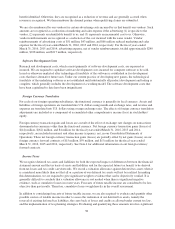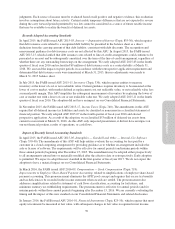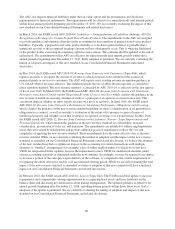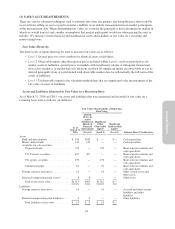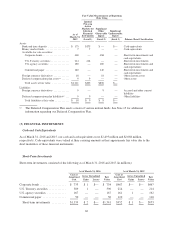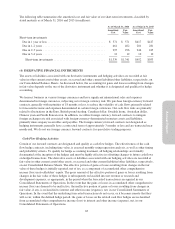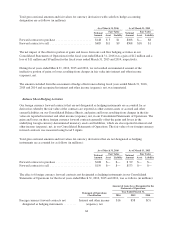Electronic Arts 2016 Annual Report Download - page 140
Download and view the complete annual report
Please find page 140 of the 2016 Electronic Arts annual report below. You can navigate through the pages in the report by either clicking on the pages listed below, or by using the keyword search tool below to find specific information within the annual report.Acquisition-Related Intangibles and Other Long-Lived Assets
We record acquisition-related intangible assets, such as developed and core technology, in connection with
business combinations. We amortize the cost of acquisition-related intangible assets that have finite useful lives
on a straight-line basis over the lesser of their estimated useful lives or the agreement terms, typically from two
to fourteen years. We evaluate acquisition-related intangibles and other long-lived assets for impairment
whenever events or changes in circumstances indicate that the carrying amount of an asset may not be
recoverable. Recoverability of assets is measured by a comparison of the carrying amount of an asset to future
undiscounted net cash flows expected to be generated by the asset group. This includes assumptions about future
prospects for the business that the asset relates to and typically involves computations of the estimated future
cash flows to be generated by these businesses. Based on these judgments and assumptions, we determine
whether we need to take an impairment charge to reduce the value of the asset stated on our Consolidated
Balance Sheets to reflect its estimated fair value. When we consider such assets to be impaired, the amount of
impairment we recognize is measured by the amount by which the carrying amount of the asset exceeds its fair
value. There were no material impairments in fiscal years 2016, 2015, and 2014.
Goodwill
In assessing impairment on our goodwill, we first analyze qualitative factors to determine whether it is more
likely than not that the fair value of a reporting unit is less than its carrying amount as a basis for determining
whether it is necessary to perform the two-step goodwill impairment test. The qualitative factors we assess
include long-term prospects of our performance, share price trends and market capitalization, and Company
specific events. If we conclude it is more likely than not that the fair value of a reporting unit exceeds its carrying
amount, we do not need to perform the two-step impairment test. If based on that assessment, we believe it is
more likely than not that the fair value of the reporting unit is less than its carrying value, a two-step goodwill
impairment test will be performed. The first step measures for impairment by applying fair value-based tests at
the reporting unit level. The second step (if necessary) measures the amount of impairment by applying fair
value-based tests to the individual assets and liabilities within each reporting unit. Reporting units are determined
by the components of operating segments that constitute a business for which (1) discrete financial information is
available, (2) segment management regularly reviews the operating results of that component, and (3) whether
the component has dissimilar economic characteristics to other components. We determined that it was more
likely than not that the fair value of our reporting unit exceeded its carrying amount and, as such, we did not need
to perform the two-step impairment test.
During the fiscal years ended March 31, 2016, 2015 and 2014, we completed our annual goodwill impairment
testing in the fourth quarter of each year and did not recognize any impairment charges.
Revenue Recognition, Sales Returns and Allowances, and Bad Debt Reserves
We derive revenue principally from sales of interactive software games, and related content (e.g., micro-
transactions) and services on consoles (such as the PlayStation from Sony and the Xbox from Microsoft), PCs,
mobile phones and tablets. We evaluate revenue recognition based on the criteria set forth in FASB Accounting
Standards Codification (“ASC”) 605, Revenue Recognition and ASC 985-605, Software: Revenue Recognition.
We classify our revenue as either product revenue or service and other revenue.
Product revenue. Our product revenue includes revenue associated with the sale of software games or related
content, whether delivered via a physical disc (e.g., packaged goods) or delivered digitally (e.g., full-game
downloads, extra-content), and licensing of game software to third-parties. Product revenue also includes revenue
from mobile full game downloads that do not require our hosting support (e.g., premium mobile games) in order
to utilize the game or related content (i.e. can be played with or without an Internet connection), and sales of
tangible products such as hardware, peripherals, or collectors’ items.
Service and other revenue. Our service revenue includes revenue recognized from time-based subscriptions and
games or related content that requires our hosting support in order to utilize the game or related content (i.e., can
54


